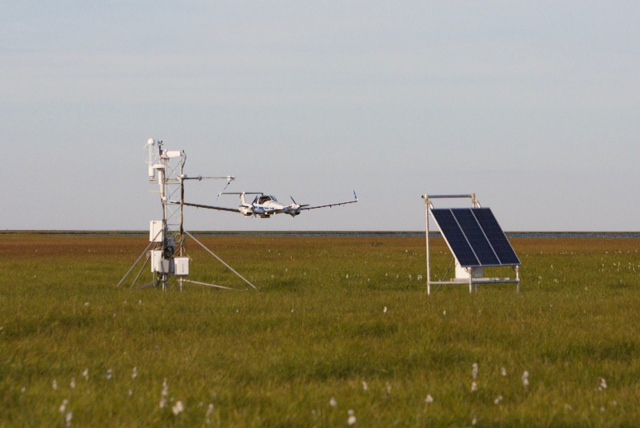Aurora Flight Sciences announced that its Centaur aircraft has completed a month-long science campaign led by Harvard University and the NOAA Atmospheric Turbulence and Diffusion Division.
Centaur is an optionally piloted aircraft that has been under development at Aurora since 2009. The first production Centaur was delivered to the Swiss Defence Agency in December 2012. The Centaur used in Alaska is owned and operated by Aurora, under a leased services agreement with Harvard. The research is sponsored by the National Science Foundation.
Between August 5, 2013 and August 30, 2013 Aurora conducted 16 flights, flying more than 60 hours for scientific data collection. Most of the flying time was at altitudes of just above 10 meters over the permafrost and coastal areas of Alaska’s North Slope. The Centaur was based at Deadhorse Airport in Prudhoe Bay, Alaska. All of the flights in the 2013 campaign were conducted in the manned mode. Plans are under way for a 2014 campaign that would utilize the remotely piloted modes.
The goal of the campaign is to provide high-resolution flux measurements of carbon dioxide, methane, and their isotopes over a large area. These gases are direct contributors to global warming and our high spatial resolution, regional-scale observations will initiate a new era in the study of carbon release from melt zones in the Arctic leading to a quantitative analysis of the rate of carbon addition to the atmosphere. This represents a critically important analysis of what is happening in the Arctic. The Harvard-developed Flux Observations of Carbon from an Airborne Laboratory (FOCAL) instrument — the most sensitive detector ever flown for these types of measurements — is coupled with the NOAA Best Air Turbulence Probe for superior spatial resolution of the carbon isotopic flux emergent from a wide variety of sources on Alaska’s North Slope.
These observations are of critical importance because the Arctic Ocean has, in just the past 30 years, lost 80% of the permanent floating ice volume resulting in rapid melting of permafrost regions in northern Alaska and Siberia that contain a vast store of methane and carbon dioxide. If just 0.5% of this methane and carbon dioxide is released each year from the surface soils of this region, it will double the total yearly carbon added to the atmosphere each year from fossil fuel combustion worldwide. Thus carbon release from the surface soils in the Arctic basin represents one of the most potent feedbacks in the climate system, and must be quantitatively mapped with high accuracy observations in order to forecast the coming changes in the Earth’s climate.
“The Optionally Piloted Aircraft is the ideal tool for this type of experiment,” said Aurora founder John Langford. “The airplane can be ferried through national and international airspace in its manned, fully-certified mode. Once the instruments, flight trajectories, and operating protocols have all been validated, the long and repetitive measurements can be handed over to the computer.”
This material is based upon work supported by the National Science Foundation under Grant No. ARC-1208254.
Photo: Centaur Flying low near NOAA Alaska Ground Tower – Ed Dumas
Source: Press Release


So, in other words, most ANY airplane with an autopilot (“handing it over to a computer”) could’ve conducted these tests and Centaur isn’t necessarily ideal, as Mr Langford suggests.